Roles of Small Polyetherimide Moieties on Thermal Stability and Fracture Toughness of Epoxy Blends
Abstract
1. Introduction
2. Materials and Methods
2.1. Materials
2.2. Preparation of Blends
2.3. Characterization and Measurements
3. Results and Discussion
3.1. Curing of the DGEBA/PEI Blends
3.2. Thermal Stability of the DGEBA/PEI Blends
3.3. Mechanical Properties of the DGEBA/PEI Blends
4. Conclusions
Supplementary Materials
Author Contributions
Funding
Institutional Review Board Statement
Informed Consent Statement
Data Availability Statement
Conflicts of Interest
References
- Jones, R.; Klein, J.; Donald, A. Mutual diffusion in a miscible polymer blend. Nature 1986, 321, 161–162. [Google Scholar] [CrossRef]
- Chen, T.; Fang, L.; Li, X.; Gao, D.; Lu, C.; Xu, Z. Self-healing polymer coatings of polyurea-urethane/epoxy blends with reversible and dynamic bonds. Prog. Org. Coat. 2020, 147, 105876. [Google Scholar] [CrossRef]
- Ji, F.; Zhou, Y.; Yang, Y. Tailoring the structure and properties of epoxy–polyurea vitrimers via controllable network reconfiguration. J. Mater. Chem. A 2021, 9, 7172–7179. [Google Scholar] [CrossRef]
- Yue, J.; He, L.; Zhao, P.; Gu, Y. Engineering Benzoxazine/Epoxy/Imidazole Blends with Controllable Microphase Structures for Toughness Improvement. ACS Appl. Polym. Mater. 2020, 2, 3458–3464. [Google Scholar] [CrossRef]
- Kim, S.-H.; Rhee, K.Y.; Park, S.-J. Amine-terminated chain-grafted nanodiamond/epoxy nanocomposites as interfacial materials: Thermal conductivity and fracture resistance. Compos. Part B Eng. 2020, 192, 107983. [Google Scholar] [CrossRef]
- Kim, S.H.; Park, S.J.; Rhee, K.Y.; Park, S.-J. Effects of ozonized carbon black on fracture and post-cracking toughness of carbon fiber-reinforced epoxy composites. Compos. Part B Eng. 2019, 177, 107379. [Google Scholar] [CrossRef]
- Farooq, U.; Teuwen, J.; Dransfeld, C. Toughening of epoxy systems with interpenetrating polymer network (IPN): A review. Polymers 2020, 12, 1908. [Google Scholar] [CrossRef] [PubMed]
- Millar, J. 263. Interpenetrating polymer networks. Styrene–divinylbenzene copolymers with two and three interpenetrating networks, and their sulphonates. J. Chem. Soc. 1960, 1311–1317. [Google Scholar] [CrossRef]
- Meng, C.; Huang, S.; Han, D.; Ren, S.; Wang, S.; Xiao, M. Semi-interpenetrating Network Membrane from Polyethyleneimine-Epoxy Resin and Polybenzimidazole for HT-PEM Fuel Cells. Adv. Polym. Technol. 2020, 2020, 3845982. [Google Scholar] [CrossRef]
- Li, H.; Gan, W.; Zhao, L.; Li, S. Studies on the Phase Separation of a Polyetherimide Modified Epoxy Resin. VI. Effect of Surface Energy on Reaction-Induced Phase Separation of Epoxy Resin Modified with Polyetherimide. J. Macromol. Sci. Part A 2003, 40, 833–846. [Google Scholar] [CrossRef]
- Lee, S.-E.; Jeong, E.; Lee, M.Y.; Lee, M.-K.; Lee, Y.-S. Improvement of the mechanical and thermal properties of polyethersulfone-modified epoxy composites. J. Ind. Eng. Chem. 2016, 33, 73–79. [Google Scholar] [CrossRef]
- Wang, Z.; Zhang, X.; Weng, L.; Liu, L. Low dielectric constant and high toughness epoxy resin based on hyperbranched polyester grafted by flexible chain modified. J. Mater. Sci. Mater. Electron. 2019, 30, 5936–5946. [Google Scholar] [CrossRef]
- Liu, J.; Fan, W.; Lu, G.; Zhou, D.; Wang, Z.; Yan, J. Semi-interpenetrating polymer networks based on cyanate ester and highly soluble thermoplastic polyimide. Polymers 2019, 11, 862. [Google Scholar] [CrossRef] [PubMed]
- Zhang, J.; Xie, X. Influence of addition of silica particles on reaction-induced phase separation and properties of epoxy/PEI blends. Compos. Part B Eng. 2011, 42, 2163–2169. [Google Scholar] [CrossRef]
- Woo, E.M. FT-IR analysis of the effects of polymeric additives on epoxy homopolymerization or hydroxyl exchanges. Polym. J. 1997, 29, 523–528. [Google Scholar] [CrossRef]
- Buketov, A.; Maruschak, P.; Sapronov, O.; Zinchenko, D.; Yatsyuk, V.; Panin, S. Enhancing Performance Characteristics of Equipment of Sea and River Transport by Using Epoxy Composites. Transport 2016, 31, 333–342. [Google Scholar] [CrossRef]
- Buketov, A.; Smetankin, S.; Maruschak, P.; Yurenin, K.; Sapronov, O.; Matvyeyev, V.; Menou, A. New Black-Filled Epoxy Coatings for Repairing Surface of Equipment of Marine Ships. Transport 2020, 35, 679–690. [Google Scholar]
- Musto, P.; Martuscelli, E.; Ragosta, G.; Russo, P.; Scarinzi, G.; Villano, P. FTIR spectroscopy and physical properties of an epoxy/bismaleimide IPN system. J. Mater. Sci. Mater. Electron. 1998, 33, 4595–4601. [Google Scholar] [CrossRef]
- Musto, P.; Karasz, F.; MacKnight, W. Fourier transform infra-red spectroscopy on the thermo-oxidative degradation of polybenzimidazole and of a polybenzimidazole/polyetherimide blend. Polymer 1993, 34, 2934–2945. [Google Scholar] [CrossRef]
- Jang, J.; Lee, W. Polyetherimide-modified high performance epoxy resin. Polym. J. 1994, 26, 513–525. [Google Scholar] [CrossRef][Green Version]
- Cole, K.C. A new approach to modeling the cure kinetics of epoxy/amine thermosetting resins. 1. Mathematical development. Macromolecules 1991, 24, 3093–3097. [Google Scholar] [CrossRef]
- Xu, L.; Schlup, J.R. Etherification versus amine addition during epoxy resin/amine cure: An in situ study using near-infrared spectroscopy. J. Appl. Polym. Sci. 1998, 67, 895–901. [Google Scholar] [CrossRef]
- Price, C.C.; Carmelite, D.D. Reactions of epoxides in dimethyl sulfoxide catalyzed by potassium t-butoxide. J. Am. Chem. Soc. 1966, 88, 4039–4044. [Google Scholar] [CrossRef]
- Park, S.J.; Kim, H.C. Thermal stability and toughening of epoxy resin with polysulfone resin. J. Polym. Sci. Part B Polym. Phys. 2001, 39, 121–128. [Google Scholar] [CrossRef]
- Wu, C.S.; Liu, Y.L.; Chiu, Y.C.; Chiu, Y.S. Thermal stability of epoxy resins containing flame retardant components: An evaluation with thermogravimetric analysis. Polym. Degrad. Stab. 2002, 78, 41–48. [Google Scholar] [CrossRef]
- Doyle, C. Estimating thermal stability of experimental polymers by empirical thermogravimetric analysis. Anal. Chem. 1961, 33, 77–79. [Google Scholar] [CrossRef]
- Horowitz, H.H.; Metzger, G. A new analysis of thermogravimetric traces. Anal. Chem. 1963, 35, 1464–1468. [Google Scholar] [CrossRef]
- Park, S.-J.; Jin, F.-L. Thermal stabilities and dynamic mechanical properties of sulfone-containing epoxy resin cured with anhydride. Polym. Degrad. Stab. 2004, 86, 515–520. [Google Scholar] [CrossRef]
- Jin, F.-L.; Park, S.-J. Thermal properties of epoxy resin/filler hybrid composites. Polym. Degrad. Stab. 2012, 97, 2148–2153. [Google Scholar] [CrossRef]
- Zhou, T.; Wang, X.; Gu, M.; Xiong, D. Study on mechanical, thermal and electrical characterizations of nano-SiC/epoxy composites. Polym. J. 2009, 41, 51–57. [Google Scholar] [CrossRef]
- Ma, X.; Liang, Y.Y.; Xu, Z.J.; Chen, S.F.; Cheng, J.; Miao, M.H.; Zhang, D.H. The versatility of hyperbranched epoxy resins containing hexahydro-s-triazine on diglycidyl ether of bisphenol-A composites. Compos. Part B-Eng. 2020, 196, 108109. [Google Scholar] [CrossRef]
- Ma, S.Q.; Liu, X.Q.; Fan, L.B.; Jiang, Y.H.; Cao, L.J.; Tang, Z.B.; Zhu, J. Synthesis and Properties of a Bio-Based Epoxy Resin with High Epoxy Value and Low Viscosity. Chemsuschem 2014, 7, 555–562. [Google Scholar] [CrossRef]
- Deng, J.; Liu, X.Q.; Li, C.; Jiang, Y.H.; Zhu, J. Synthesis and properties of a bio-based epoxy resin from 2,5-furandicarboxylic acid (FDCA). RSC Adv. 2015, 5, 15930–15939. [Google Scholar] [CrossRef]
- Sudha, G.S.; Kalita, H.; Mohanty, S.; Nayak, S.K. Biobased Epoxy Blends from Epoxidized Castor Oil: Effect on Mechanical, Thermal, and Morphological Properties. Macromol. Res. 2017, 25, 420–430. [Google Scholar] [CrossRef]
- Zhu, J.; Chandrashekhara, K.; Flanigan, V.; Kapila, S. Curing and mechanical characterization of a soy-based epoxy resin system. J. Appl. Polym. Sci. 2004, 91, 3513–3518. [Google Scholar] [CrossRef]
- Unnikrishnan, K.P.; Thachil, E.T. Synthesis and Characterization of Cardanol-Based Epoxy Systems. Des. Monomers Polym. 2008, 11, 593–607. [Google Scholar] [CrossRef]
- Guo, B.; Jia, D.; Cai, C. Effects of organo-montmorillonite dispersion on thermal stability of epoxy resin nanocomposites. Eur. Polym. J. 2004, 40, 1743–1748. [Google Scholar] [CrossRef]
- Qiu, J.J.; Wang, S.R. Enhancing Polymer Performance Through Graphene Sheets. J. Appl. Polym. Sci. 2011, 119, 3670–3674. [Google Scholar] [CrossRef]
- Kim, K.S.; Rhee, K.Y.; Lee, K.H.; Byun, J.H.; Park, S.J. Rheological behaviors and mechanical properties of graphite nanoplate/carbon nanotube-filled epoxy nanocomposites. J. Ind. Eng. Chem. 2010, 16, 572–576. [Google Scholar] [CrossRef]
- Pressly, T.G.; Keskkula, H.; Paul, D.R. Temperature dependence of the fracture behavior of nylon 6/ABS blends. Polymer 2001, 42, 3043–3055. [Google Scholar] [CrossRef]
- Kim, W.J.; Heo, Y.J.; Lee, J.H.; Rhee, K.Y.; Park, S.J. Effect of Atmospheric-Pressure Plasma Treatments on Fracture Toughness of Carbon Fibers-Reinforced Composites. Molecules 2021, 26, 3698. [Google Scholar] [CrossRef]
- Park, Y.T.; Qian, Y.Q.; Chan, C.; Suh, T.; Nejhad, M.G.; Macosko, C.W.; Stein, A. Epoxy Toughening with Low Graphene Loading. Adv. Funct. Mater. 2015, 25, 575–585. [Google Scholar] [CrossRef]
- Gong, L.X.; Zhao, L.; Tang, L.C.; Liu, H.Y.; Mai, Y.W. Balanced electrical, thermal and mechanical properties of epoxy composites filled with chemically reduced graphene oxide and rubber nanoparticles. Compos. Sci. Technol. 2015, 121, 104–114. [Google Scholar] [CrossRef]
- Park, S.J.; Seo, M.K.; Ma, T.J.; Lee, D.R. Effect of chemical treatment of Kevlar fibers on mechanical interfacial properties of composites. J. Colloid Interface Sci. 2002, 252, 249–255. [Google Scholar] [CrossRef]
- Park, S.J.; Jang, Y.S.; Rhee, K.Y. Interlaminar and ductile characteristics of carbon fibers-reinforced plastics produced by nanoscaled electroless nickel plating on carbon fiber surfaces. J. Colloid Interface Sci. 2002, 245, 383–390. [Google Scholar] [CrossRef] [PubMed]
- Katti, P.; Bose, S.; Kumar, S. Tailored interface resulting in improvement in mechanical properties of epoxy composites containing poly (ether ether ketone) grafted multiwall carbon nanotubes. Polymer 2016, 102, 43–53. [Google Scholar] [CrossRef]
- Park, S.J.; Seo, M.K.; Lee, D.R. Studies on the mechanical and mechanical interfacial properties of carbon-carbon composites impregnated with an oxidation inhibitor. Carbon 2003, 41, 2991–3002. [Google Scholar] [CrossRef]
- Fu, S.Y.; Feng, X.Q.; Lauke, B.; Mai, Y.W. Effects of particle size, particle/matrix interface adhesion and particle loading on mechanical properties of particulate-polymer composites. Compos. Part B-Eng. 2008, 39, 933–961. [Google Scholar] [CrossRef]
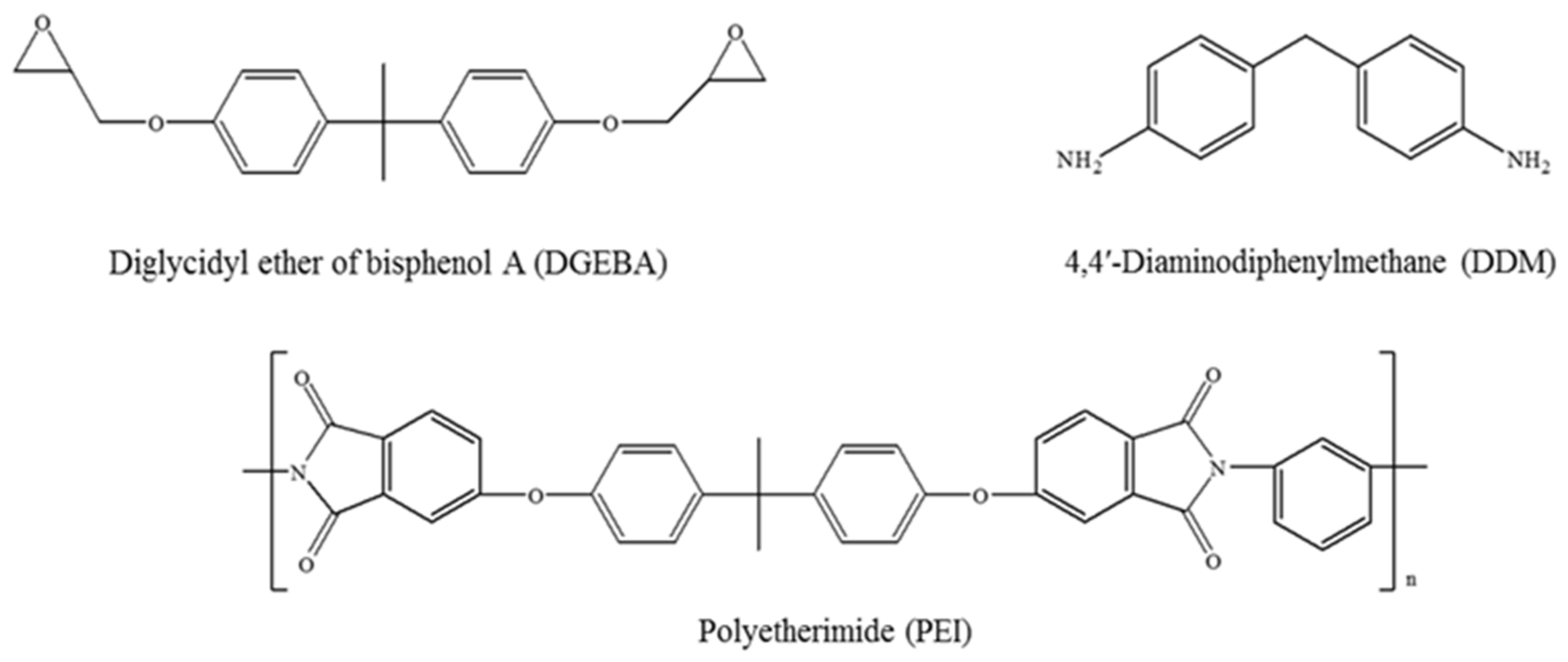
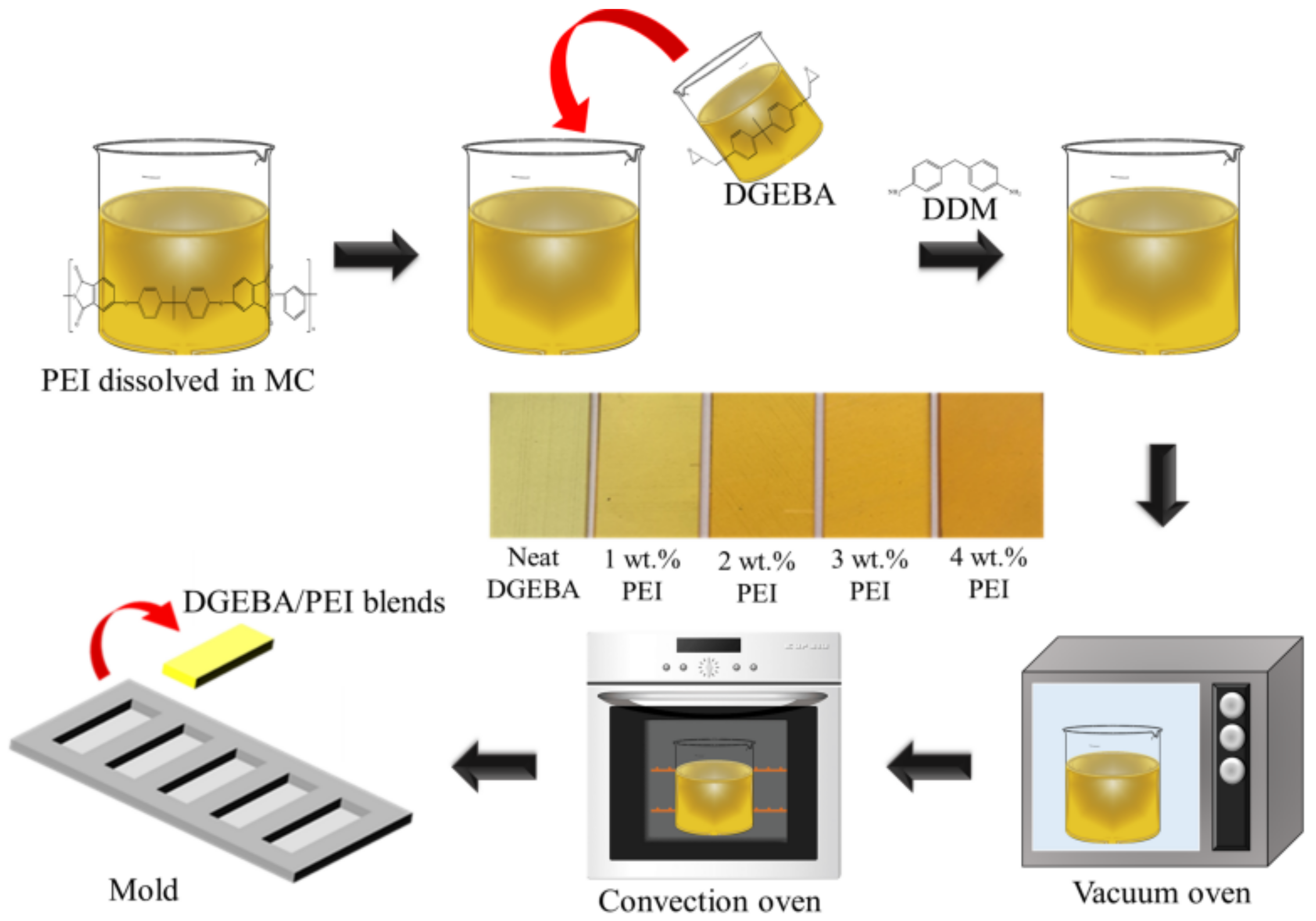
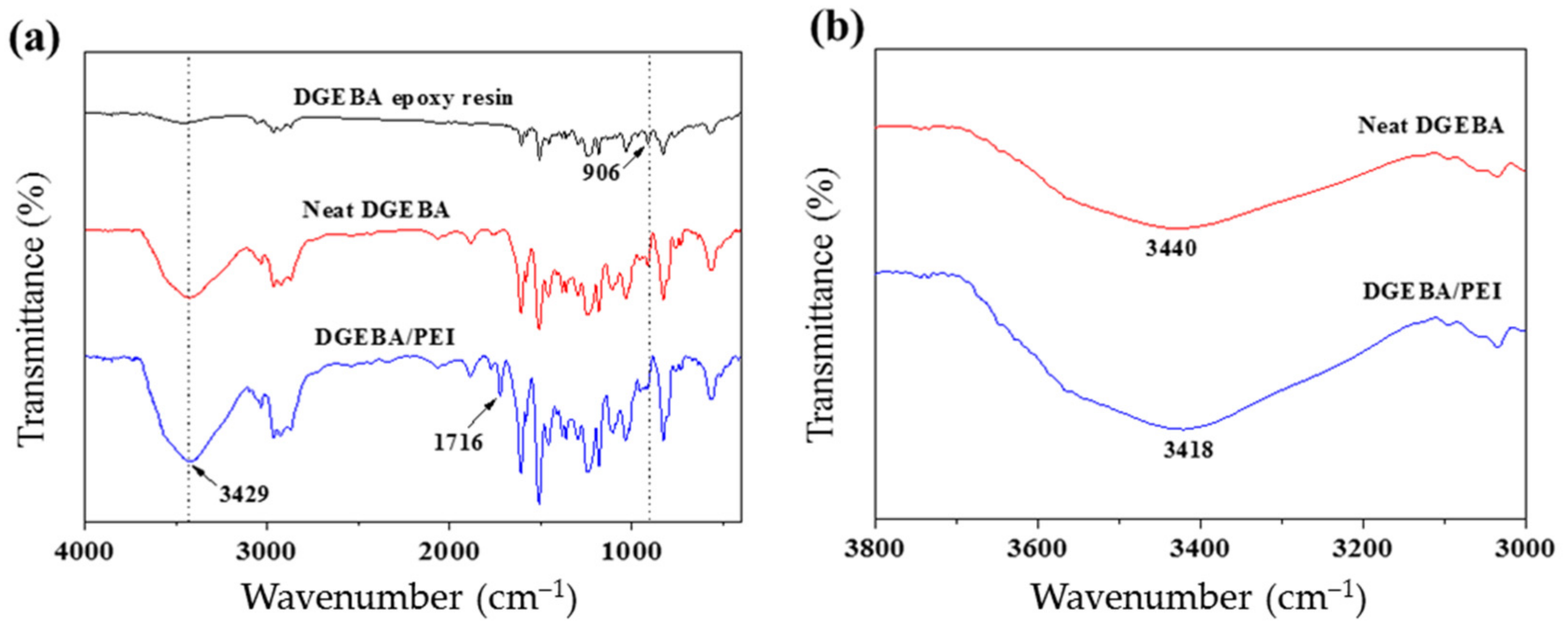


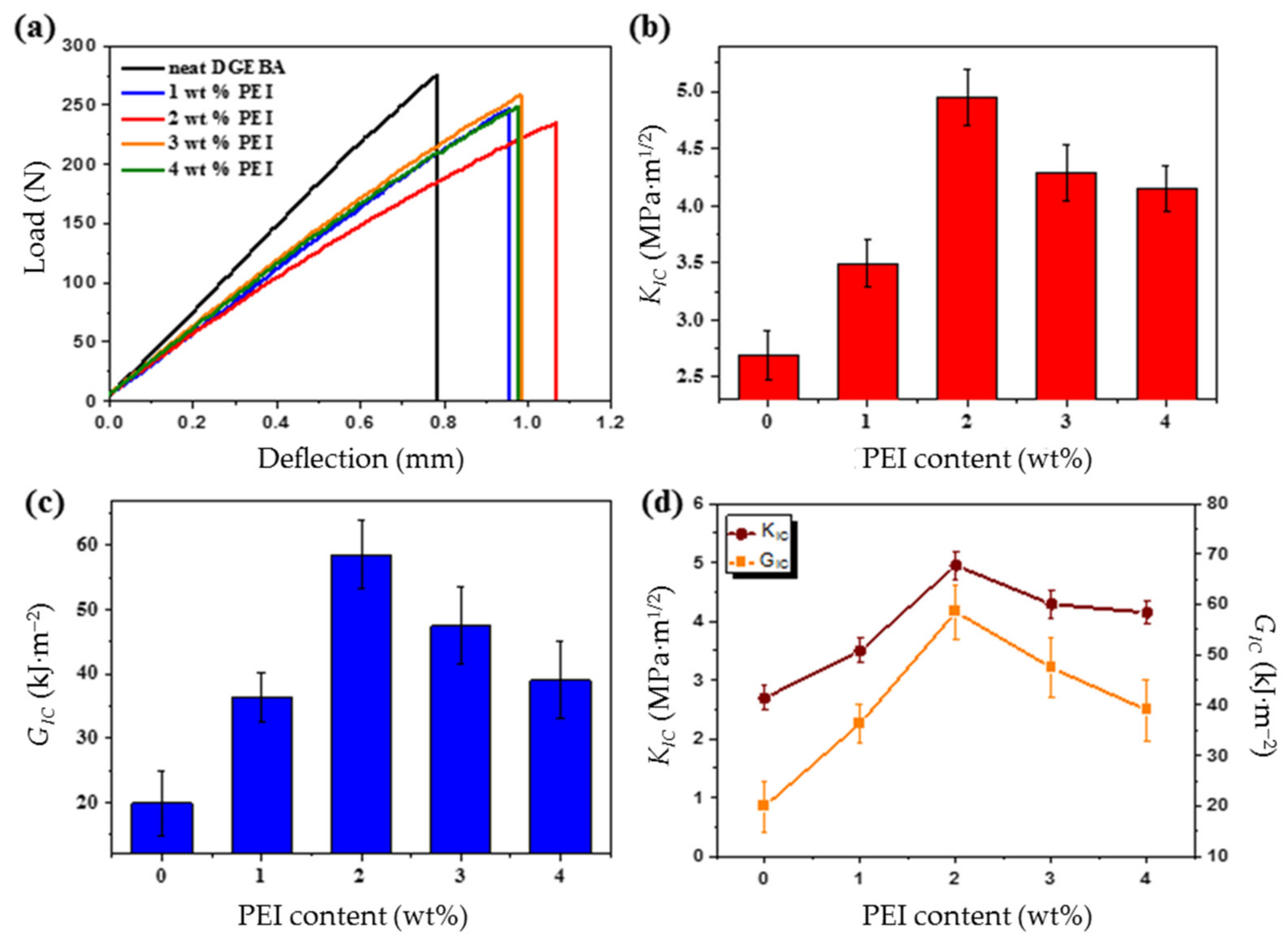
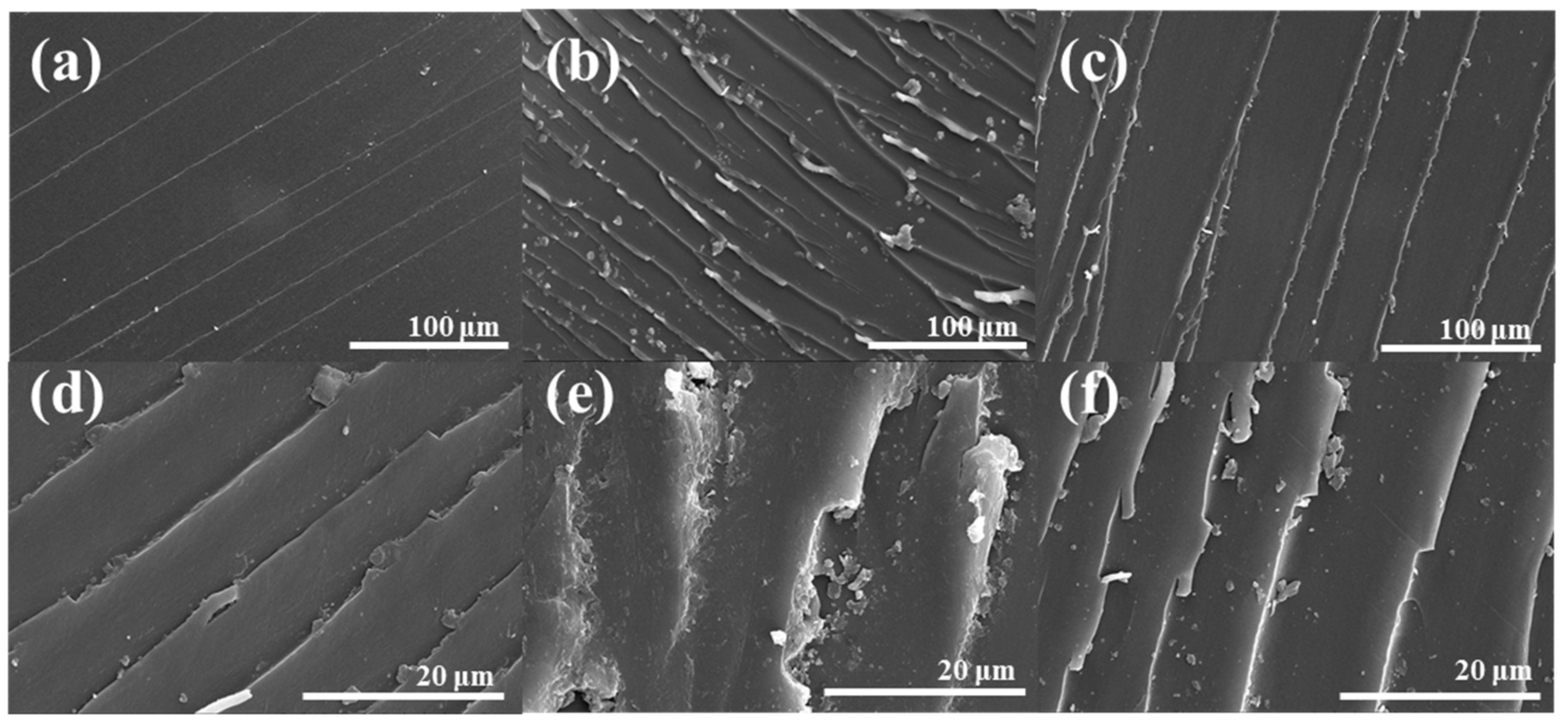
| Specimen | 1 PDT (°C) | 2A*K* | 3 IPDT (°C) | 4Tmax (°C) | 5Et (kJ·mol−1) |
|---|---|---|---|---|---|
| neat DGEBA | 364.1 | 0.81 | 399.5 | 379.9 | 256.3 |
| 1 wt% of PEI | 366.3 | 0.82 | 401.7 | 379.9 | 294.0 |
| 2 wt% of PEI | 366.8 | 0.86 | 404.4 | 379.9 | 312.8 |
| 3 wt% of PEI | 366.7 | 0.84 | 402.6 | 379.9 | 306.9 |
| 4 wt% of PEI | 366.6 | 0.81 | 401.8 | 379.9 | 303.3 |
Publisher’s Note: MDPI stays neutral with regard to jurisdictional claims in published maps and institutional affiliations. |
© 2021 by the authors. Licensee MDPI, Basel, Switzerland. This article is an open access article distributed under the terms and conditions of the Creative Commons Attribution (CC BY) license (https://creativecommons.org/licenses/by/4.0/).
Share and Cite
Lee, S.-Y.; Kang, M.-J.; Kim, S.-H.; Rhee, K.Y.; Lee, J.-H.; Park, S.-J. Roles of Small Polyetherimide Moieties on Thermal Stability and Fracture Toughness of Epoxy Blends. Polymers 2021, 13, 3310. https://doi.org/10.3390/polym13193310
Lee S-Y, Kang M-J, Kim S-H, Rhee KY, Lee J-H, Park S-J. Roles of Small Polyetherimide Moieties on Thermal Stability and Fracture Toughness of Epoxy Blends. Polymers. 2021; 13(19):3310. https://doi.org/10.3390/polym13193310
Chicago/Turabian StyleLee, Seul-Yi, Min-Joo Kang, Seong-Hwang Kim, Kyong Yop Rhee, Jong-Hoon Lee, and Soo-Jin Park. 2021. "Roles of Small Polyetherimide Moieties on Thermal Stability and Fracture Toughness of Epoxy Blends" Polymers 13, no. 19: 3310. https://doi.org/10.3390/polym13193310
APA StyleLee, S.-Y., Kang, M.-J., Kim, S.-H., Rhee, K. Y., Lee, J.-H., & Park, S.-J. (2021). Roles of Small Polyetherimide Moieties on Thermal Stability and Fracture Toughness of Epoxy Blends. Polymers, 13(19), 3310. https://doi.org/10.3390/polym13193310






